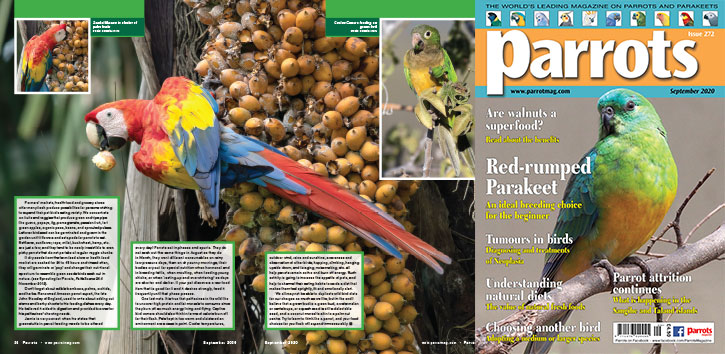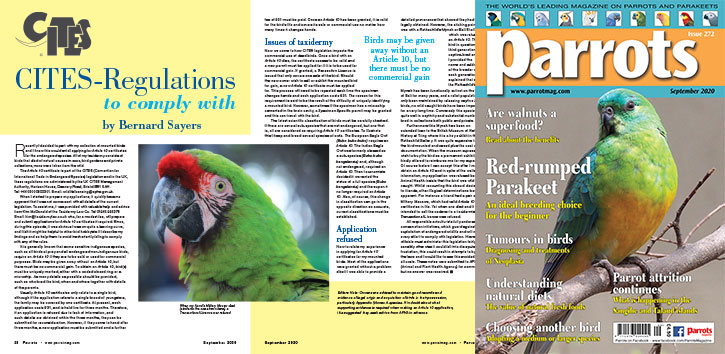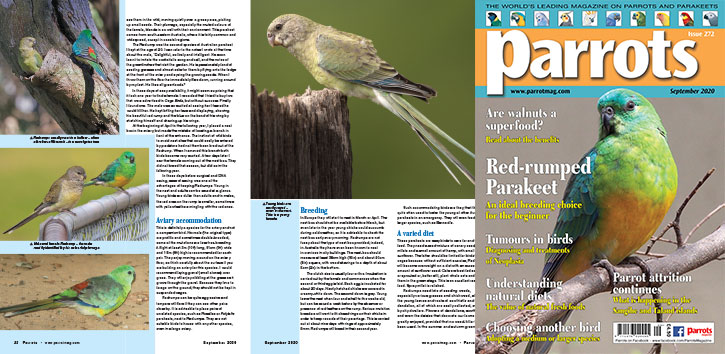
Does Your Parrot Need a Friend? Part II – Friends for larger birds
One of the difficult points of being a pet psittacine owner is when you decide to purchase or adopt another hookbill in the hope of it becoming an acquaintance to your existing bird. This can be especially difficult if you own a jealous or possessive type of parrot.
If not undertaken carefully, such a move can bring discord into a normally calm avian home. However, there are certain species of psittacine that often may be better accepted as the ‘newcomer.’ When dealing with the medium and larger kinds of psittacines, it is usually necessary to move ahead with even more caution, as the bigger the parrot, the more dangerous could be the interactions between prospective companions.
I have introduced or counselled many larger hookbill friendships over the years and have developed some favoured species for bringing into a birdkeeper’s home. Each species and gender has its own advantages both for the owner and for the birds themselves.
Buy Now!

In this part II of Jamie Gilardi’s article on wild diets, he teams up with Eb Cravens who has always been an advocate of fresh natural foods
The only sure way to adequately reproduce a wild parrot diet with a captive psittacine would be to live in the bird’s native range, and release it daily to feed with others of its own kind. Rather impossible for most pet owners, right?
That being said, it is quite possible to make solid attempts at mimicking wild bird feeding tendencies with our domestic cage birds. In doing so, we must first recognise that what we are seeking is not so much a ‘wild’ diet, but a ‘natural’ diet. Feeding a natural diet means that every effort has been made to eliminate several processed foods from the food bowl. Not all such items are banished of course, since proper nourishment (with occasional relished people treats!) is the ultimate goal with any parrot. But where possible, it is best to replace processed substances with raw, natural foods.
First of all, we should consider just how most parrots and parakeets eat. Have you ever watched an African Grey or Sun Conure consume a shelled walnut? They hold the nut in a foot, or bend down over the dish in the case of species such as Eclectus or Regent’s Parrot, and slowly masticate the nut into a fine powder, consuming some, wasting much, and seeking out the important essential fats and oils. Unless they’re in a hungry hurry or feeding ravenous chicks, few parrots will take food or nuts in big chunks. Instead they chew and chew, deriving nourishment and moisture from the juices, oils, mineral-rich crumbs, chlorophyll, plant enzymes and the like. That is precisely why there is often so much detritus to be observed falling from a tree where groups of wild parrots are feeding. A softbill or non-seed cracking bird will ingest a whole guava seed. A psittacine will grind it to a pulpy mess. It’s almost as if parrots prefer ‘blenderised’ fare to a regular chunky meal.
Buy Now!

By Bernard Sayers
Recently I decided to part with my collection of mounted birds and I knew this would entail applying for Article 10 certificates for the endangered species. All of my taxidermy consists of birds that died of natural causes in zoos, bird gardens and private collections, none were taken from the wild.
The Article 10 certificate is part of the CITES (Convention for International Trade in Endangered Species) legislation and in the UK, these regulations are administered by the UK CITES Management Authority, Horizon House, Deanery Road, Bristol BS1 5AH.
When I started to prepare my applications, it quickly became apparent that I was not conversant with all details of the current legislation. To assist me, I was provided with valuable help and advice from Kim McDonald of the Taxidermy Law Co. who, for a modest fee, will prepare and submit applications for Article 10 certificates if required. Since, during this episode, it was obvious I was on quite a learning curve, and I felt it might be helpful to other bird hobbyists if I describe my findings and so help them to avoid inadvertently failing to comply with any of the rules.
Buy Now!

By Rosemary Low
A request from a reader regarding problems to be avoided by beginners to parrot breeding resulted in my articles in the July and August issues. For those contemplating breeding parakeets the next question is: “Which species can you recommend?”
If this question had been asked three or four decades ago one likely answer would have been: the Red-rumped Parakeet (Psephotus haematonotus). It has so much to recommend it as an aviary bird that it is difficult to understand how its popularity declined.
Excluding the Neophemas, the Redrump was the most widely kept parakeet. Affordable and free-breeding, friendly and hardy, it introduced many breeders to the world of Australian parakeets. Its medium size, 27cm (10½in) makes it easier to house than the larger parakeets. Another asset is its voice with its soft whistles that are not only pleasant, but almost musical. Yet another advantage is that this species is sexually dimorphic. The gender of young, even when still in the nest, is easily recognised.
Buy Now!




